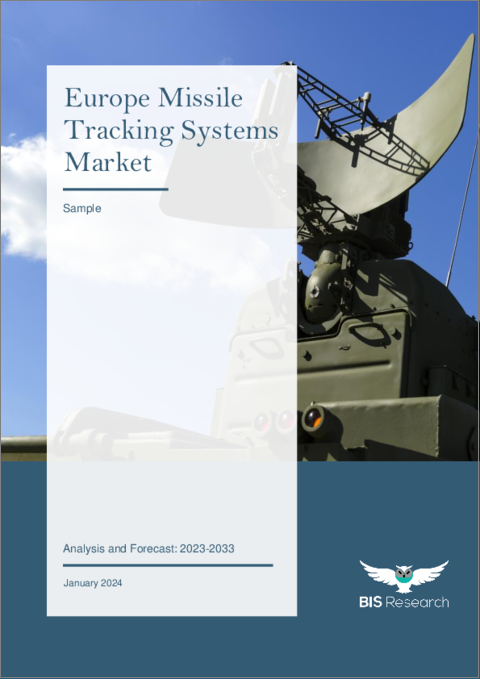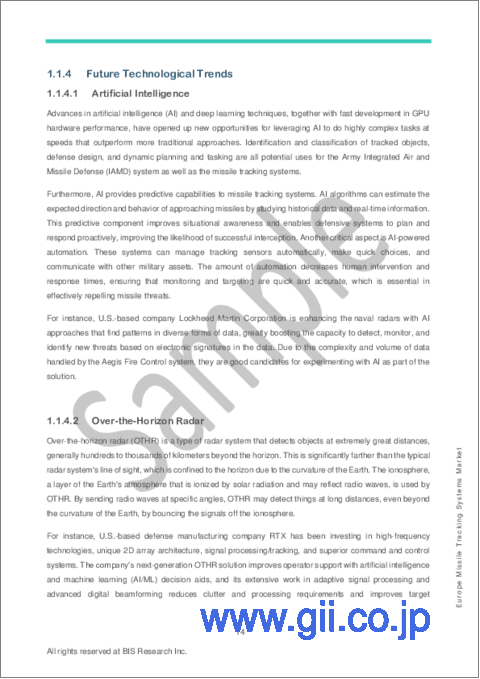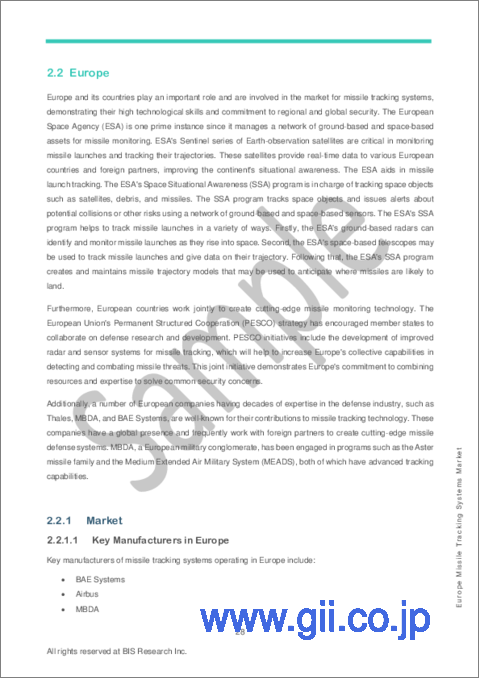|
|
市場調査レポート
商品コード
1408029
欧州のミサイル追跡システム市場:分析と予測(2023年~2033年)Europe Missile Tracking Systems Market: Analysis and Forecast, 2023-2033 |
||||||
カスタマイズ可能
|
|||||||
| 欧州のミサイル追跡システム市場:分析と予測(2023年~2033年) |
|
出版日: 2024年01月15日
発行: BIS Research
ページ情報: 英文 86 Pages
納期: 1~5営業日
|
全表示
- 概要
- 図表
- 目次
欧州のミサイル追跡システムの市場規模は、2023年の213億4,000万米ドルから2033年には352億6,000万米ドルに達し、予測期間の2023年~2033年のCAGRは5.15%になると予測されています。
ミサイル追跡システムの進化の旅は、現代の戦争における精度と有効性の必要性に後押しされた、技術の進歩の魅力的な物語として展開されます。第二次世界大戦では、レーダー技術が接近する敵機を探知・追跡することに革命的な変化をもたらしました。科学者やエンジニアが、レーダーが飛行機だけでなくミサイルも追跡できる可能性を認識したことで、初期のミサイル追跡システムが誕生しました。しかし、これらの初期のシステムは、今日の洗練された技術に比べれば初歩的なものでした。冷戦期を通じて、ミサイル追跡システムは大きな進化を遂げました。大陸間弾道ミサイル(ICBM)、亜音速ミサイル、超音速ミサイル、そして最新の極超音速ミサイルがもたらすエスカレートする脅威に対応するため、より強力で正確なソリューションを開発しようとする超大国間の世界の競争が原動力となっています。この時代には、弾道ミサイル早期警戒システム(BMEWS)やそのソ連版に相当するような高度なミサイル追跡レーダー・ネットワークが確立され、膨大な距離のICBMを探知・追跡できるようになっています。その後、衛星ベースのシステム、GPSセンサー、赤外線センサーが統合され、ミサイル追跡能力がさらに強化され、より正確なミサイルの探知と迎撃が可能になっています。
| 主要市場統計 | |
|---|---|
| 予測期間 | 2023年~2033年 |
| 2023年の評価額 | 213億4,000万米ドル |
| 2033年予測 | 352億6,000万米ドル |
| CAGR | 5.15% |
欧州のミサイル追跡システム市場は、地政学的緊張とミサイル技術の進歩により、ダイナミックな変化を経験しています。地域の安全保障にとって強固なミサイル追跡システムが極めて重要な役割を果たすことを認識し、ミサイルを正確に探知、追跡、迎撃できる高度なソリューションに対する需要が高まっています。欧州諸国は、ミサイル防衛能力を強化するため、レーダーシステム、赤外線センサー、衛星ベースの追跡などの最先端技術に多額の投資を行っています。ミサイル追跡システムを選択する際には、相互運用性、拡張性、サイバー耐障害性などの要素を優先することが推奨されます。新たなミサイルの脅威に対する効率的な防衛には、欧州諸国と業界の利害関係者の協力が不可欠です。技術の進歩や規制状況の変化に関する情報を常に入手することは、欧州ミサイル追跡システム市場の進化する情勢をナビゲートするために不可欠です。
当レポートでは、欧州のミサイル追跡システム市場について調査し、市場の概要とともに、用途別、プラットフォーム別、国別の動向、および市場に参入する企業のプロファイルなどを提供しています。
目次
エグゼクティブサマリー
調査範囲
第1章 市場
- 業界の展望
- ビジネスダイナミクス
- 事業戦略
第2章 地域
- ミサイル追跡システム市場(地域別)
- 欧州
- 市場
- 応用
- 製品
- 欧州(国別)
第3章 競合ベンチマーキングと企業プロファイル
- 市場シェア分析
- 企業プロファイル
- Thales
- Leonardo S.p.A.
- BAE Systems
- Weibel Scientific A/S
- ASELSAN A.S.
第4章 成長の機会と提言
- 成長の機会
- 成長の機会:システム製造における3Dプリンティングの採用
- 成長の機会:IoT統合によるミサイル追跡機能の強化
第5章 調査手法
List of Figures
- Figure 1: Missile Tracking Systems Market, $Billion, 2022-2033
- Figure 2: Share of Missile Tracking Systems Market (by Region), $Billion, 2033
- Figure 3: Cost Analysis by Platform
- Figure 4: Missile Tracking Systems Market (by Application), $Billion, 2023 and 2033
- Figure 5: Market Share Analysis, by Space-based Missile Tracking Systems Platform
- Figure 6: Missile Tracking Systems Value Chain
- Figure 7: Missile Tracking Systems Market, Business Dynamics
- Figure 8: Share of Key Business Strategies and Developments, January 2021- October 2023
- Figure 9: Missile Tracking Systems Market in Defense Share (by Company), 2022
- Figure 10: Missile Tracking Systems Market in Defense Share (by Company),2022
- Figure 11: Missile Tracking Systems Market in Defense Share (by Company),2022
- Figure 12: Missile Tracking Systems Market in Defense Share (by Company),2022
- Figure 13: Research Methodology
- Figure 14: Top-Down and Bottom-Up Approach
- Figure 15: Assumptions and Limitations
List of Tables
- Table 1: Ground-based Missile Tracking Systems
- Table 2: Naval-based Missile Tracking Systems
- Table 3: Category of Missile Tracking Systems Platform Manufacturers
- Table 4: Missile Tracking Systems Platform Manufacturers' Developments
- Table 5: Category of Payload/Component Facilitators
- Table 6: Partnerships, Collaborations, Agreements, and Contracts, January 2021-October 2023
- Table 7: Market Developments, January 2021-October 2023
- Table 8: Missile Tracking Systems Market (by Region), $Billion, 2022-2033
- Table 9: Europe Missile Tracking Systems Market (by Application), $Billion, 2022-2033
- Table 10: Europe Missile Tracking Systems Market (by Platform), $Billion, 2022-2033
- Table 11: U.K. Missile Tracking Systems Market (by Application), $Billion, 2022-2033
- Table 12: U.K. Missile Tracking Systems Market (by Platform), $Billion, 2022-2033
- Table 13: France Missile Tracking Systems Market (by Application), $Billion, 2022-2033
- Table 14: France Missile Tracking Systems Market (by Platform), $Billion, 2022-2033
- Table 15: Germany Missile Tracking Systems Market (by Application), $Billion, 2022-2033
- Table 16: Germany Missile Tracking Systems Market (by Platform), $Billion, 2022-2033
- Table 17: Russia Missile Tracking Systems Market (by Application), $Billion, 2022-2033
- Table 18: Russia Missile Tracking Systems Market (by Platform), $Billion, 2022-2033
- Table 19: Rest-of-Europe Missile Tracking Systems Market (by Application), $Billion, 2022-2033
- Table 20: Rest-of-Europe Missile Tracking Systems Market (by Platform), $Billion, 2022-2033
- Table 21: Thales: Product Portfolio
- Table 22: Thales: Partnerships, Collaborations, Agreements, and Contracts
- Table 23: Leonardo S.p.A.: Product Portfolio
- Table 24: Leonardo S.p.A.: Market Developments
- Table 25: BAE Systems: Product Portfolio
- Table 26: BAE Systems: Partnerships, Collaborations, Agreements, and Contracts
- Table 27: Weibel Scientific A/S: Product Portfolio
- Table 28: ASELSAN A.S.: Product Portfolio
“The Europe Missile Tracking Systems Market Market Expected to Reach $35.26 Billion by 2033.”
Introduction to Europe Missile Tracking Systems Market
The Europe missile tracking systems market is projected to reach $35.26 billion by 2033 from $21.34 billion in 2023, growing at a CAGR of 5.15% during the forecast period 2023-2033. The journey of missile tracking systems' evolution unfolds as a fascinating narrative of technological advancements, propelled by the imperative for precision and effectiveness in contemporary warfare. In World War II, radar technology brought about a revolutionary shift in detecting and tracking approaching enemy aircraft. As scientists and engineers recognized radar's potential for tracking not only airplanes but also missiles, it marked the inception of early missile tracking systems. However, these initial systems were rudimentary compared to today's sophisticated technology. Throughout the Cold War, there was a significant evolution in missile tracking systems, driven by the global competition between superpowers to develop more potent and accurate solutions in response to the escalating threat posed by intercontinental ballistic missiles (ICBMs), subsonic and supersonic missiles, and the latest entrant, hypersonic missiles. This era saw the establishment of advanced missile-tracking radar networks like the Ballistic Missile Early Warning System (BMEWS) and its Soviet counterpart, capable of detecting and tracking ICBMs across vast distances. Subsequent integration of satellite-based systems, GPS sensors, and infrared sensors further enhanced missile tracking capabilities, enabling more precise detection and interception of missiles.
| KEY MARKET STATISTICS | |
|---|---|
| Forecast Period | 2023 - 2033 |
| 2023 Evaluation | $21.34 Billion |
| 2033 Forecast | $35.26 Billion |
| CAGR | 5.15% |
Market Introduction
The European Missile Tracking Systems Market is experiencing a dynamic shift due to geopolitical tensions and ongoing advancements in missile technology. Recognizing the crucial role of robust missile tracking systems for regional security, there is an increased demand for advanced solutions capable of precisely detecting, tracking, and intercepting missiles. European nations are heavily investing in cutting-edge technologies such as radar systems, infrared sensors, and satellite-based tracking to enhance their missile defense capabilities. Prioritizing factors like interoperability, scalability, and cyber resilience is advised when selecting missile tracking systems. Collaborative efforts among European countries and industry stakeholders are crucial for an efficient defense against emerging missile threats. Staying informed about technological advancements and regulatory changes is essential for navigating the evolving landscape of the European Missile Tracking Systems Market.
Market Segmentation:
Segmentation 1: by Application
- Target Acquisition
- Air Defense
- Space Domain Awareness
- Early Warning Capabilities
Segmentation 2: by Platform
- Space-Based Missile Tracking Systems
- Ground-Based Missile Tracking Systems
- Naval-Based Missile Tracking Systems
- Airborne-Based Missile Tracking Systems
Segmentation 3: by Country
- U.K.
- Germany
- France
- Russia
- Rest-of-Europe
How can this report add value to an organization?
Product/Innovation Strategy: The product segment helps the reader understand the different types of products available for deployment and their potential in Europe region. Moreover, the study provides the reader with a detailed understanding of the missile tracking systems market by application on the basis of application (target acquisition, air defense, space domain awareness, and early warning capabilities) and product on the basis of platform (space-based missile defense systems, ground-based missile defense systems, naval-based missile defense systems, and airborne-based missile defense systems).
Growth/Marketing Strategy: The missile tracking systems market has seen major development by key players operating in the market, such as business expansion, partnership, collaboration, and joint venture. The favored strategy for the companies has been partnerships and contracts to strengthen their position in the missile tracking systems market.
Competitive Strategy: Key players in the missile tracking systems market analyzed and profiled in the study involve major missile tracking systems offering companies providing missile tracking systems for the purpose. Moreover, a detailed competitive benchmarking of the players operating in the missile tracking systems market has been done to help the reader understand how players stack against each other, presenting a clear market landscape. Additionally, comprehensive competitive strategies such as partnerships, agreements, and collaborations will aid the reader in understanding the untapped revenue pockets in the market.
Methodology: The research methodology design adopted for this specific study includes a mix of data collected from primary and secondary data sources. Both primary resources (key players, market leaders, and in-house experts) and secondary research (a host of paid and unpaid databases), along with analytical tools, are employed to build the predictive and forecast models.
Key Market Players and Competition Synopsis
The companies that are profiled have been selected based on thorough secondary research, which includes analyzing company coverage, product portfolio, market penetration, and insights gathered from primary experts.
Some prominent names established in this market are:
|
|
Table of Contents
Executive Summary
Scope of the Study
1. Market
- 1.1. Industry Outlook
- 1.1.1. Missile Tracking Systems Market: Overview
- 1.1.2. Evolving Missile Tracking Technologies in the Defense Industry
- 1.1.3. On-going and Upcoming Programs
- 1.1.3.1. Hypersonic and Ballistic Tracking Space Sensor (HBTSS)
- 1.1.3.2. Proliferated Warfighter Space Architecture (PWSA)
- 1.1.4. Future Technological Trends
- 1.1.4.1. Artificial Intelligence
- 1.1.4.2. Over-the-Horizon Radar
- 1.1.5. Comparative Analysis of Different Platforms
- 1.1.5.1. Ground-based Missile Tracking Systems
- 1.1.5.2. Naval-based Missile Tracking Systems
- 1.1.6. Value Chain Analysis
- 1.2. Business Dynamics
- 1.2.1. Business Drivers
- 1.2.1.1. Geopolitical Conflicts and Tensions
- 1.2.1.2. Emerging Hypersonic Armament Capabilities
- 1.2.1.3. Replacement of Legacy Systems
- 1.2.2. Business Challenges
- 1.2.2.1. Advancements in Stealth Technologies
- 1.2.2.2. Complex Sensor Integration
- 1.2.2.3. Efficient Data Transmission
- 1.2.3. Business Opportunities
- 1.2.3.1. AI and ML Integration
- 1.2.3.2. Directed Energy Weapons
- 1.2.1. Business Drivers
- 1.3. Business Strategies
- 1.3.1. Partnerships, Collaborations, Agreements, and Contracts
- 1.3.2. Market Developments
2. Region
- 2.1. Missile Tracking Systems Market (by Region)
- 2.2. Europe
- 2.2.1. Market
- 2.2.1.1. Key Manufacturers in Europe
- 2.2.1.2. Business Drivers
- 2.2.1.3. Business Challenges
- 2.2.2. Application
- 2.2.2.1. Europe Missile Tracking Systems Market (by Application)
- 2.2.3. Product
- 2.2.3.1. Europe Missile Tracking Systems Market (by Platform)
- 2.2.4. Europe (by Country)
- 2.2.4.1. U.K.
- 2.2.4.1.1. Market
- 2.2.4.1.1.1. Key Manufacturers in the U.K.
- 2.2.4.1.2. Application
- 2.2.4.1.2.1. U.K. Missile Tracking Systems Market (by Application)
- 2.2.4.1.3. Product
- 2.2.4.1.3.1. U.K. Missile Tracking Systems Market (by Platform)
- 2.2.4.1.1. Market
- 2.2.4.2. France
- 2.2.4.2.1. Market
- 2.2.4.2.1.1. Key Manufacturers in France
- 2.2.4.2.2. Application
- 2.2.4.2.2.1. France Missile Tracking Systems Market (by Application)
- 2.2.4.2.3. Product
- 2.2.4.2.3.1. France Missile Tracking Systems Market (by Platform)
- 2.2.4.2.1. Market
- 2.2.4.3. Germany
- 2.2.4.3.1. Market
- 2.2.4.3.1.1. Key Manufacturers in Germany
- 2.2.4.3.2. Application
- 2.2.4.3.2.1. Germany Missile Tracking Systems Market (by Application)
- 2.2.4.3.3. Product
- 2.2.4.3.3.1. Germany Missile Tracking Systems Market (by Platform)
- 2.2.4.3.1. Market
- 2.2.4.4. Russia
- 2.2.4.4.1. Market
- 2.2.4.4.1.1. Key Manufacturers in Russia
- 2.2.4.4.2. Application
- 2.2.4.4.2.1. Russia Missile Tracking Systems Market (by Application)
- 2.2.4.4.3. Product
- 2.2.4.4.3.1. Russia Missile Tracking Systems Market (by Platform)
- 2.2.4.4.1. Market
- 2.2.4.5. Rest-of-Europe
- 2.2.4.5.1. Application
- 2.2.4.5.1.1. Rest-of-Europe Missile Tracking Systems Market (by Application)
- 2.2.4.5.2. Product
- 2.2.4.5.2.1. Rest-of-Europe Missile Tracking Systems Market (by Platform)
- 2.2.4.5.1. Application
- 2.2.4.1. U.K.
- 2.2.1. Market
3. Competitive Benchmarking and Company Profiles
- 3.1. Market Share Analysis
- 3.2. Company Profiles
- 3.2.1. Thales
- 3.2.1.1. Company Overview
- 3.2.1.1.1. Role of Thales in the Missile Tracking Systems Market
- 3.2.1.1.2. Product Portfolio
- 3.2.1.2. Corporate Strategies
- 3.2.1.2.1. Partnerships, Collaborations, Agreements, and Contracts
- 3.2.1.3. Analyst View
- 3.2.1.1. Company Overview
- 3.2.2. Leonardo S.p.A.
- 3.2.2.1. Company Overview
- 3.2.2.1.1. Role of Leonardo S.p.A. in the Missile Tracking Systems Market
- 3.2.2.1.2. Product Portfolio
- 3.2.2.2. Business Strategies
- 3.2.2.2.1. Market Developments
- 3.2.2.3. Analyst View
- 3.2.2.1. Company Overview
- 3.2.3. BAE Systems
- 3.2.3.1. Company Overview
- 3.2.3.1.1. Role of BAE Systems in the Missile Tracking Systems Market
- 3.2.3.1.2. Product Portfolio
- 3.2.3.2. Corporate Strategies
- 3.2.3.2.1. Partnerships, Collaborations, Agreements, and Contracts
- 3.2.3.3. Analyst View
- 3.2.3.1. Company Overview
- 3.2.4. Weibel Scientific A/S
- 3.2.4.1. Company Overview
- 3.2.4.1.1. Role of Weibel Scientific A/S in the Missile Tracking Systems Market
- 3.2.4.1.2. Product Portfolio
- 3.2.4.2. Analyst View
- 3.2.4.1. Company Overview
- 3.2.5. ASELSAN A.S.
- 3.2.5.1. Company Overview
- 3.2.5.1.1. Role of ASELSAN A.S. in the Missile Tracking Systems Market
- 3.2.5.1.2. Product Portfolio
- 3.2.5.2. Analyst View
- 3.2.5.1. Company Overview
- 3.2.1. Thales
4. Growth Opportunities and Recommendations
- 4.1. Growth Opportunities
- 4.1.1. Growth Opportunity: Adoption of 3D Printing in Systems Manufacturing
- 4.1.1.1. Recommendations
- 4.1.2. Growth Opportunity: Enhanced Missile Tracking Capabilities with IoT Integration
- 4.1.2.1. Recommendations
- 4.1.1. Growth Opportunity: Adoption of 3D Printing in Systems Manufacturing
5. Research Methodology
- 5.1. Factors for Data Prediction and Modeling





